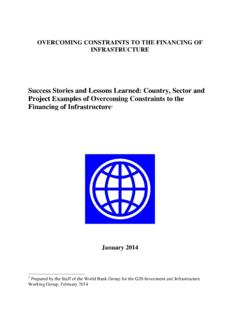Transcription of The Structure And Performance Of Ethiopia’s …
1 The Structure And Performance Of ethiopia 's financial sector In The Pre And Post Reform Period: With Special Focus On Banking Alemayehu Geda1. Abstract Since 1992 ethiopia has been engaged in liberalizing its financial sector . The hallmark of the strategy is gradualism. The approach is not without problems especially from Bretton Woods Institutions that saw the reform as a sluggish process. This study examines this liberalization program by analyzing the Performance of the sector before and after the reform. The study notes that given the recent nascent development the financial sector in the country, the relatively good shape in which the existing financial institutions find themselves, and given that supervision and regulation capacity of the regulating agency is weak, the government's strategy of gradualism and its over all reform direction is encouraging. However, we argue for charting out clearly defined time frame for liberalization and exploring the possibility of engaging with foreign banks to acquire new technology that enhance the efficiency of the financial sector in general and the banking sector in particular.
2 1. Introduction One of the main objectives of financial institutions is mobilizing resources (in particular domestic saving) and channeling them to the would-be investors. This intermediation role of financial institutions takes different forms in different economic systems. ethiopia 's history of the last three decades clearly shows the validity of this statement. Under State Socialism' (1974 to 1991), popularly referred in ethiopia as the Derge2 Regime', financial institutions were basically executing the economic plans outlined by the central planning organ. In that periodp regulation and supervision were not critical since the national plan was believed to regulate and direct the activities of the financial institutions. Moreover, financial institutions were directed to finance some public projects that may not pass proper financial appraisal simply based on either ideological ground or merit wants' argument. Following the demise of the Derg regime in 1991, post-1991 economic policy witnessed a marked departure from the previous Socialist' System.
3 Its main difference lies on openly adopting a 1. Associate Professor, Department of Economics, Addis Ababa University,. P. Box 1176, AAU, Addis Ababa, ethiopia . E-mail or , Web page: . I thank my former students Seife Dender and Abera Sebeta for their help in the course of writing this paper. 2 An Amharic term meaning the committee (of solders). Alemayehu Geda 2. market-oriented economic policy. In fact much of the policies adopted by the new government in Addis in 1991 had been already proposed by the defunct Derge regime virtually at the end of its reign. This new change in policy brought about a significant change in the functioning of the financial sector . Not only is the financial sector is going to serve the private sector , which hitherto had been demonized, but also new private financial institutions were emerging. Equally the role of the ethiopia 's central bank (named National Bank of ethiopia , NBE henceforth) was also reformulated. Thus, financial sector reconstruction was the top item in the government's agenda.
4 In undertaking this task the Ethiopian government adopted a strategy of (a) gradualism: gradual opening up of private banks and insurance companies alongside the public ones, gradual liberalization of the foreign exchange market etc and (b) strengthening domestic competitive capacity before full liberalization (ie., restrict the sector to domestic investors, strengthening the regulatory and supervision capacity of the NBE, providing autonomy to banks as well as opening up inter-bank money market etc). In line with this strategy various proclamations and regulations were passed since 1992 (See Alemayehu and Seife 2001). The rest of the paper is organized as follows. In section two a brief overview of banking history in ethiopia is made. This will be followed by section three where the analysis of the financial sector in the pre and post reform periods is made. Section four concludes the chapter. 2 Brief Banking History One can trace the history of using modern money in ethiopia to more than 2000 years (Pankhrust in Belay, 1990).
5 This had flourished in what is called the Axumite era which can stretch from 1000BC to around 975 AD. Leaving that long history aside, modern banking in ethiopia started in 1905 with the establishment of Abysinian Bank based on a 50 years agreement with the Anglo-Egyptian National Bank. In 1908 a new development bank (named Societe Nationale d'Ethiope Pour le Development de l' Agriculture et du Commerce) and two other foreign banks (Banque de l'Indochine and the Compagnie de l' Afrique Oreintale) were also established (Pankhrust (1968) cited in Befekadu, 1995). These banks were criticized for being wholly foreign owned. In 1931 the Ethiopian government purchased the Abysinian Bank, which was the dominant bank, and renamed it the Bank of ethiopia ' the first nationally owned bank on African continent (Belay, 1990: 83; Befekadu, 1995: 234). During the five-years of Italian occupation there was an expansion of banking activity. In particular the Italian banks were active.
6 Table 2(a) shows banks that were in operation during this period. After independence from Italy's brief occupation (of 1933-1941) where the role of British was paramount owing to its strategic consideration in World War II, Barclay's bank had established and was in business in ethiopia from 1941 to 1943 (See Belay 1990; Befekadu, 1995). Following this, in 1943, the Ethiopian government established the State Bank of ethiopia '. The establishment of this Bank by ethiopia was a painful process since Britain was against it (See Befekadu (1995) for an interesting neo-colonial story). This bank was operating both as The Structure and Performance of ethiopia 's financial sector 3. commercial and central bank until 1963 when it was dissolved into today's National Bank of ethiopia (the central bank, re established in 1976) and The Commercial Bank of ethiopia ', CBE. henceforth. After this period many other banks were established; and just before the 1974. revolution the following banks were in operation (See Table 2b).
7 {Insert Tables 2a and 2b here}. All privately owned financial institutions including three commercial banks, thirteen insurance companies and two non-bank financial intermediaries were nationalized on 1 January 19753. The nationalized banks were reorganized and one commercial bank (the Commercial Bank of ethiopia ), a National Bank (recreated in 1976), two specialized banks (the Agricultural and Industrial Bank renamed recently as the Development Bank of ethiopia ; and a Housing and Saving Bank renamed recently as the Construction and Business Bank) as well as one insurance company Ethiopian Insurance Company were formed. Following the regime change in 1991. and the liberalization policy in 1992, these financial institutions were reorganized to work on market-oriented policy framework. Besides, new privately owned financial institutions were also allowed to work along the publicly owned ones. The discussion about these financial institutions is the subject of the rest of this chapter.
8 3. The Structure and Performance of the financial System in the Pre and Post Reform Period Following the Mckinnon (1973) and Shaw's (1973) paradigm, financial liberalization has been high on the agenda of developing countries. The financial repression school - as it is sometimes referred to - argues that government intervention in the sector (in particular through subsidized interest rate and (favored) credit allocation) not only distorts the financial market but also depresses saving and leads to inefficient investment. The policy prescription that follows is liberalization. This has been endorsed by international financial and development institutions (such as the World Bank and IMF) and had been high on the agenda of reform packages that came with name Structural Adjustment Programs'/SAPs. Many developing countries, except a few in Asia, that went through this agonizing reform process are unable to enjoy what is promised in this package in general and the financials sector prosperity in particular.
9 Vos (1993) noted that the major factors that could explain the failure of 3. The commercial banks were Addis Ababa Bank, Banco di Napoli and Banco di Roma. The insurance companies were African Solidarity, Ethio-American life, Blue Nile, Ethiopian General, Imperial, Afro-Continental, Pan-African, Union, Ras, and Ethiopian Life and Rasi. The non-bank financial intermediaries were the Imperial Saving and Home Ownership Public Association and the Mortgage Corporation (Befekadu, 1995: 273). Alemayehu Geda 4. financial liberalization in Latin America and its success in Asian developing countries (such as Korea and Taiwan) lies in the control and intervention by state to address structural problems without disregarding market-oriented Performance criteria. Thus, for Vos gradualism and addressing some of the setbacks in the financial sector reform, such as lack of sensible prudential and supervisory capacity in place before the on set of the financial sector reform, are crucial.
10 The Pre-Reform financial sector The pre-reform period here refers to the period 1974 to 1991, which I noted as the Derge regime before. During this period all private banks were nationalized. The National Bank of ethiopia (NBE) was at the apex of the banking Structure and was engaged in all the functions of a central bank. As noted earlier, CBE, AIDB (DBE), HSB (CBB) were in operation. In addition to these banks, there were also two other financial institutions: Ethiopian Insurance Corporation (EIC). and the Pension and Social Security Authority (PSSA). The CBE, followed by the DBE, was/is the most important banks in the country both before and after reform. On the average the CBE alone comprises more than 90% of total deposit (while DBE's share is ), and 71% of the total loans advanced (DBE's share being 16%). Owing to the dominant position of these two banks, the major activities and Performance of these two banks is outlined below. This will provide us with a good picture of banking activity in the country both before and after the 1992 reform.







